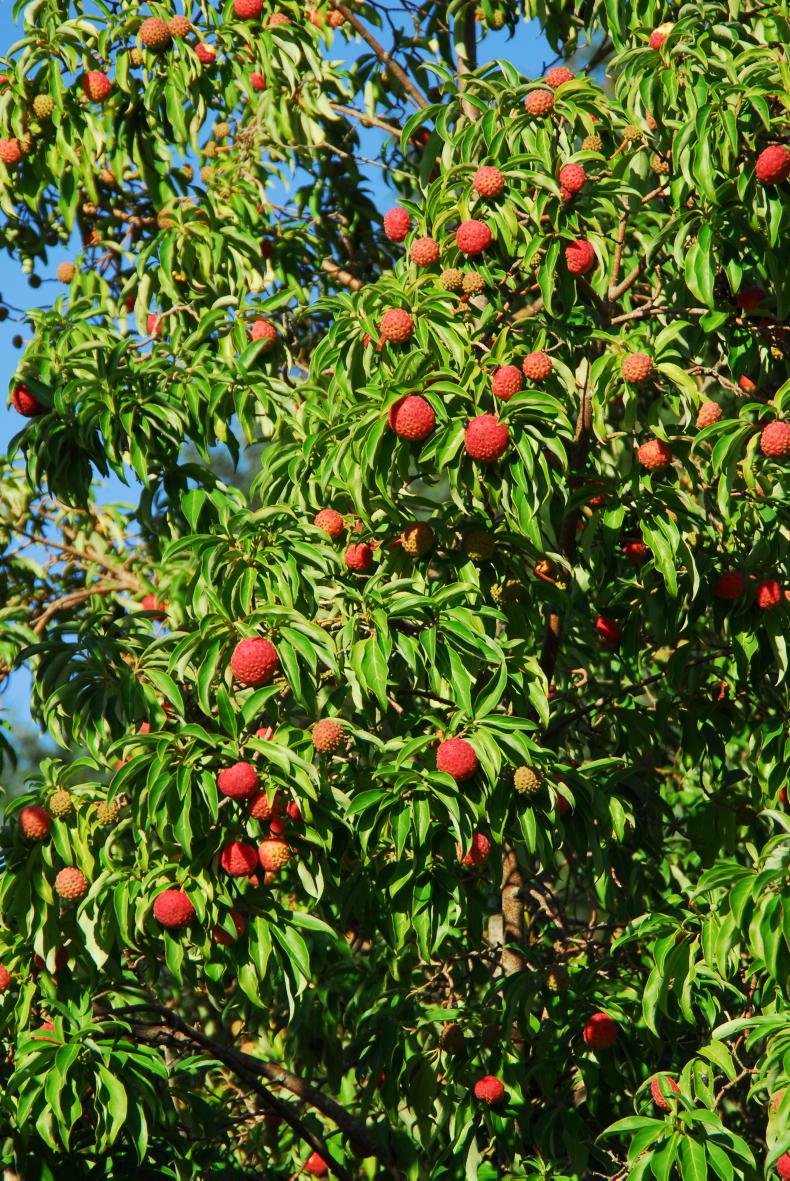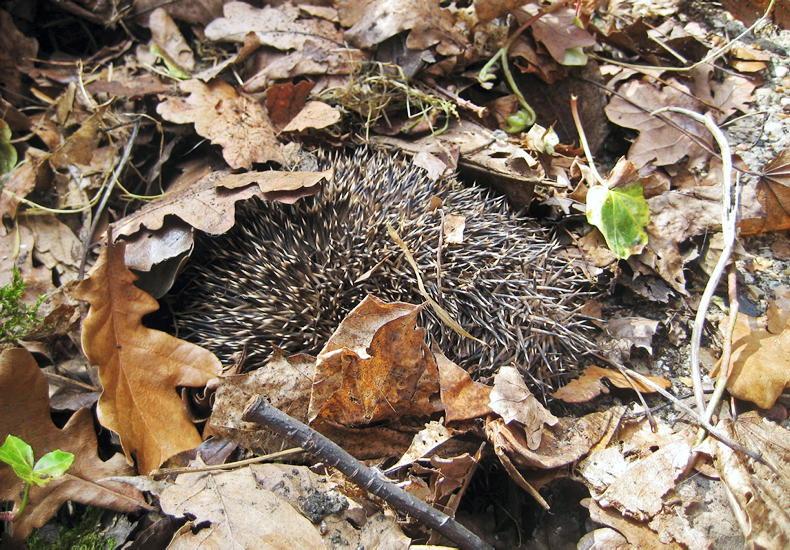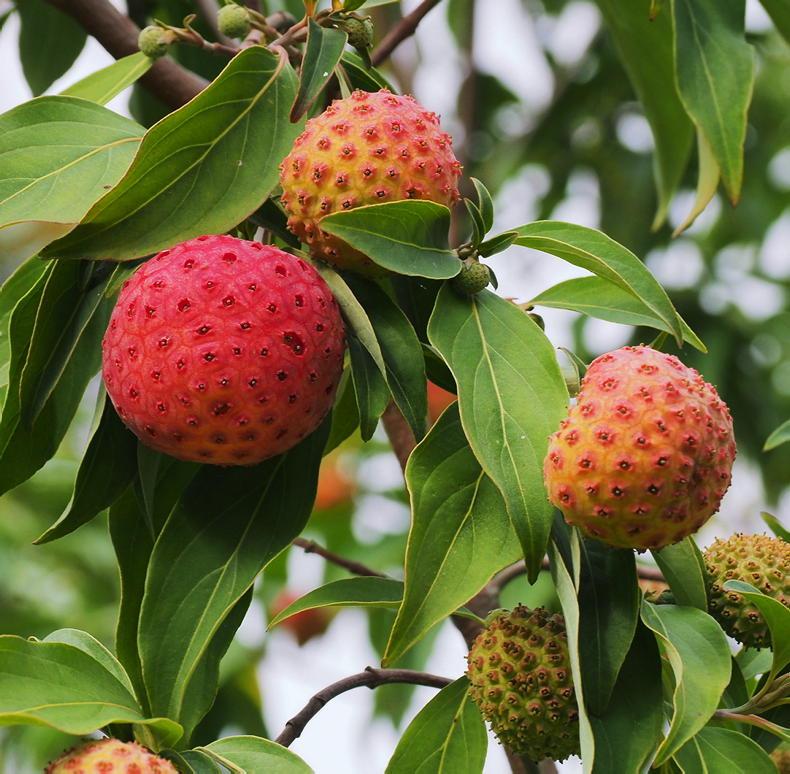Common name: Chinese strawberry tree, also sometimes known as Wicklow strawberry tree.
Botanical name: Cornus capitata.
Botanical family: Cornaceae, the dogwood family.
Decorative features
The Chinese strawberry tree is considered botanically to be part of the dogwood family, but it is easy not to make the connection as the resemblances are minute, but they are present nonetheless in the leaves and fruits.
Unlike its better-known cousins, the dogwoods that show bright winter colour of the bark on bare stems, this branch of the family shows no bark colour, apart from green. Also, this is a tree capable of growing to four to six metres in height and almost as much in width.

Cornus capitata.
It is evergreen with handsome foliage all year round. It has beautiful flowers composed of four cream-white bracts and the true flower parts at the centre. The actual flowers themselves are unspectacular. Sometimes, the white flowers are tinged with red pigment.
When the fruit has set after flowering, the berries, which are strawberry-like in colour and size, begin to swell, first green and slowly changing to red during autumn and early winter.
Garden use
This very fine garden tree is unfortunately hardly known and seldom planted in gardens. It makes a very good feature tree either on its own in grass or planted among shrubs or perennial flowers in a mixed border. The red fruits are very decorative at the tail end of the year. Although when they fully ripen, and soften, birds come to feed.
Soil requirements
This tree is very easy to satisfy as regards soil requirements, growing in any ordinary soil, limy or acidic, but the soil should be well-drained. It is easy to propagate from seed taken from ripe fruit. And it is not unusual to find self-sown seedlings close to the parent tree.
Site requirements
Although it is reputed not to be fully hardy, it is much hardier than it is given credit for, and some decades-old specimens are occasionally seen in gardens. It is true that it is somewhat susceptible to frost damage as a young plant, but it should be OK in cold inland gardens. It grows rapidly and looks best with swathes of white flowers and red fruit when given enough room and not cramped.
Hedgehog hibernation

Hedgehog.
The charm of the hedgehog story of hibernation features widely in children’s story books, but the practice of hibernation in winter is vitally important for the survival of this common garden denizen. Although it is believed that numbers have fallen, hedgehogs are fairly frequent in the countryside and in gardens and it can come as a surprise that it is not a native species.
Hibernation is a survival strategy to cope with the drastically reduced quantity of food available to this creature. Slugs and snails form a large part of its diet and these, as well as insects, disappear under shelter in winter. Hedgehogs also eat berries and fruit, including windfall apples.
Garden hedgehogs are not seen very often, as they don’t move about in daylight. The best evidence that they are occupying a garden is to find black droppings about the size of a cigarette butt or a little bigger. The more droppings, the more hedgehog activity is taking place.
As winter approaches, hedgehogs seek out dry places under leaves, log piles, and frequently at the edges of a compost heap, which often emits some warmth. Be careful not to disturb hedgehogs in such places, and if they are discovered, cover them up again and allow them to get back to their winter sleep. A hedgehog may change position if disturbed and they have been known to temporarily break their hibernation if there is a prolonged warm spell.
Trees, shrubs and roses
Planting is best done during dry weather. Do not plant into heavy wet ground. Check that young trees are securely staked – wind-rocking can seriously damage to the bark, and even kill, young trees that are not yet wind-firm. Shrubs that are loose will need staking.
Fruit and vegetables
Plant new fruit trees and bushes. Apply weedkillers to established fruit trees and bushes. Prune fruit trees and bushes now. Dig over vegetable ground, removing old crops. Control weeds over areas of ground that will be dug over later. Spread compost before digging it in.
Flowers
Wallflowers, pansies and bachelors buttons could still be planted, especially if they are available in pots. Small plants are not worth planting as they will make no growth to compensate. If not already done, lift dahlias, begonias and gladiolus in frosty localities.
Lawns
If the lawn is mossy, apply sulphate of iron. Moss growth can build up to competitive levels. If the soil is firm, a mowing before the year-end is a good idea to remove late grass-growth. Grass tends to grow a little over winter and an occasional mowing will keep it neat.
Greenhouse and house plants
A greenhouse frost protection heater will save tender plants, such as geraniums or fuchsias, on a frosty night. A small electric heater is cheap to buy and cheap to run. Remove all debris and dead plants, and ventilate occasionally. Water very little to avoid grey mould disease.
Read more
Gardening with Gerry Daly: live oaks
In the garden with Gerry Daly: wonderful windflower
Common name: Chinese strawberry tree, also sometimes known as Wicklow strawberry tree.
Botanical name: Cornus capitata.
Botanical family: Cornaceae, the dogwood family.
Decorative features
The Chinese strawberry tree is considered botanically to be part of the dogwood family, but it is easy not to make the connection as the resemblances are minute, but they are present nonetheless in the leaves and fruits.
Unlike its better-known cousins, the dogwoods that show bright winter colour of the bark on bare stems, this branch of the family shows no bark colour, apart from green. Also, this is a tree capable of growing to four to six metres in height and almost as much in width.

Cornus capitata.
It is evergreen with handsome foliage all year round. It has beautiful flowers composed of four cream-white bracts and the true flower parts at the centre. The actual flowers themselves are unspectacular. Sometimes, the white flowers are tinged with red pigment.
When the fruit has set after flowering, the berries, which are strawberry-like in colour and size, begin to swell, first green and slowly changing to red during autumn and early winter.
Garden use
This very fine garden tree is unfortunately hardly known and seldom planted in gardens. It makes a very good feature tree either on its own in grass or planted among shrubs or perennial flowers in a mixed border. The red fruits are very decorative at the tail end of the year. Although when they fully ripen, and soften, birds come to feed.
Soil requirements
This tree is very easy to satisfy as regards soil requirements, growing in any ordinary soil, limy or acidic, but the soil should be well-drained. It is easy to propagate from seed taken from ripe fruit. And it is not unusual to find self-sown seedlings close to the parent tree.
Site requirements
Although it is reputed not to be fully hardy, it is much hardier than it is given credit for, and some decades-old specimens are occasionally seen in gardens. It is true that it is somewhat susceptible to frost damage as a young plant, but it should be OK in cold inland gardens. It grows rapidly and looks best with swathes of white flowers and red fruit when given enough room and not cramped.
Hedgehog hibernation

Hedgehog.
The charm of the hedgehog story of hibernation features widely in children’s story books, but the practice of hibernation in winter is vitally important for the survival of this common garden denizen. Although it is believed that numbers have fallen, hedgehogs are fairly frequent in the countryside and in gardens and it can come as a surprise that it is not a native species.
Hibernation is a survival strategy to cope with the drastically reduced quantity of food available to this creature. Slugs and snails form a large part of its diet and these, as well as insects, disappear under shelter in winter. Hedgehogs also eat berries and fruit, including windfall apples.
Garden hedgehogs are not seen very often, as they don’t move about in daylight. The best evidence that they are occupying a garden is to find black droppings about the size of a cigarette butt or a little bigger. The more droppings, the more hedgehog activity is taking place.
As winter approaches, hedgehogs seek out dry places under leaves, log piles, and frequently at the edges of a compost heap, which often emits some warmth. Be careful not to disturb hedgehogs in such places, and if they are discovered, cover them up again and allow them to get back to their winter sleep. A hedgehog may change position if disturbed and they have been known to temporarily break their hibernation if there is a prolonged warm spell.
Trees, shrubs and roses
Planting is best done during dry weather. Do not plant into heavy wet ground. Check that young trees are securely staked – wind-rocking can seriously damage to the bark, and even kill, young trees that are not yet wind-firm. Shrubs that are loose will need staking.
Fruit and vegetables
Plant new fruit trees and bushes. Apply weedkillers to established fruit trees and bushes. Prune fruit trees and bushes now. Dig over vegetable ground, removing old crops. Control weeds over areas of ground that will be dug over later. Spread compost before digging it in.
Flowers
Wallflowers, pansies and bachelors buttons could still be planted, especially if they are available in pots. Small plants are not worth planting as they will make no growth to compensate. If not already done, lift dahlias, begonias and gladiolus in frosty localities.
Lawns
If the lawn is mossy, apply sulphate of iron. Moss growth can build up to competitive levels. If the soil is firm, a mowing before the year-end is a good idea to remove late grass-growth. Grass tends to grow a little over winter and an occasional mowing will keep it neat.
Greenhouse and house plants
A greenhouse frost protection heater will save tender plants, such as geraniums or fuchsias, on a frosty night. A small electric heater is cheap to buy and cheap to run. Remove all debris and dead plants, and ventilate occasionally. Water very little to avoid grey mould disease.
Read more
Gardening with Gerry Daly: live oaks
In the garden with Gerry Daly: wonderful windflower








 This is a subscriber-only article
This is a subscriber-only article










SHARING OPTIONS: